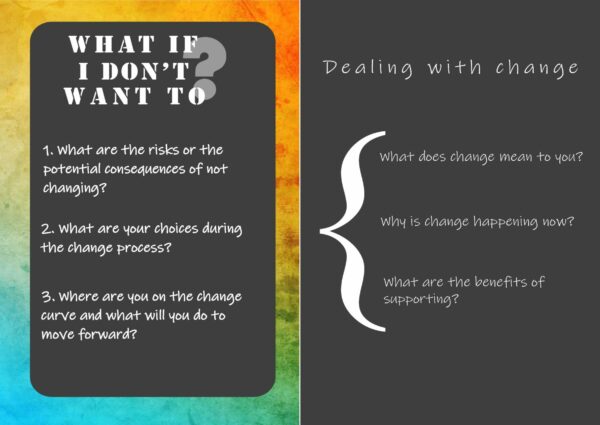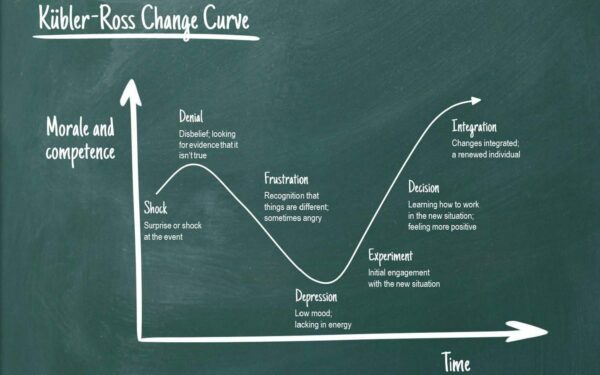For many trainers, statements like, “This was a great training, I just wish I knew what to do with it!?” or “This was really good, I just wish my supervisor was here to hear this!” are all too common.
While getting the skills we teach integrated into the day-to-day behaviors of our employees, it can be frustrating hearing these types of comments, as they indicate barriers that prevent new knowledge from taking hold in an organization.
In the summer of 2014, a training peer and I were sitting together discussing the feedback we had received from a recent training series we had completed. As we reviewed the feedback, we were consistently seeing responses that hinted at barriers or people who might prevent them from implementing what we had just taught.
Several other comments hinted that the training would be more widely accepted if their own supervisor had been present. Working in an organization where it was common for leaders to send their team, yet not attend themselves, we wanted to find a way to break this habit. Using a napkin left over from breakfast, we started writing down ideas of different training methodologies we felt we could try.
For our organization, we had a long history of the typical training delivery: Presenter, PowerPoint and handouts. The presenter would go through the PowerPoint, and it would be more of a “Sage on the Stage” type experience.
We knew if we wanted to change the way training was viewed, we had to do something different. From our ideation session, the “How to” series was developed.

At the time, the “How to” series went against many norms around training delivery. Instead of us using PowerPoint, there would be no technology. Instead of plain paper handouts — which somehow always ended up in the trash receptacle next to the door — we would be intentional and include a short booklet that had been designed and printed in color. Instead of us providing a “lecture,” we would ask questions. Additionally, for this series, we only delivered the training to teams. We moved away from open enrollment for the “How to” series to ensure we were committing our efforts to in-tact working groups.
We wanted to completely change the way training was delivered within our organization – and we did. Fast forward nine years, and the “How to” series is still alive and well. And, expectations changed; employees now get upset when they are faced with a PowerPoint and lecture.
So, what was that process we followed? The method we used for creating these training courses has been consistent and has provided us with the opportunity to broaden perspectives and increase engagement with our training. The intent of the “How to” series is to be focused and intentional with a topic. Start by picking one. By narrowing in on a specific topic, you create the space for clarity in expected behaviors.
First, what are the topics you feel would be beneficial for your organization? Topics consistently used for us include the following, among others:
- Communication
- Trust
- Respect
- Change
- Conflict
- Resilience
- Team-building
We have even used our organizational values as topics to assist in operationalizing our guiding behaviors.
Once you have your topic, you need to determine what questions you want to ask.
For example, in our training on change, we will ask the following questions to begin the training:
- What does change mean to you?
- Why is change happening now for you and your team?
- What are the benefits of supporting change?
It is recommended that you use between three and five questions at the beginning of the training.
Next is the model. The topics we are discussing have a number of models connected to them. What do you like? What works for your team? Select one model that will help you bring the topic to life.
For our change training, we use the Kubler-Ross Change Curve. While the intent was to support terminal patients and family members dealing with end-of-life care, it has been modified to align with the business environment. Using this model through experiential learning allows the employees to connect to each of the stages and allows them to see that we all experience the same feelings and thoughts when dealing with change.

Could we use a different model? Yes. That’s the beauty of this. Pick what works for you.
When you are working through the model, it is also recommended to include some activities for the teams to move and engage with each other. For example, in the team-building training, we use Tuckman’s Four Stages of team development. With “forming,” we will ask questions such as:
- What’s one thing most people don’t know about you?
- What is your role on the team? What would be missing if you left?
When we discuss “storming,” we will do an activity like the “bus stop”:
- Employees stand in a line – meaning, they are on the bus.
- Give the employees a pairing to think about (do you prefer daytime or nighttime? Cat or dog? Listen or talk? Comedy or action?)
- Have them stand on either the left or right side of the line – they stay on the bus or they get off.
- When employees have selected their side – or if they stayed in the middle – ask them why. This conversation encourages employees to share their opinions on topics that are safe to disagree about.
When we discuss “norming,” we will have employees break into groups and compete with each other through building a spaghetti tower with marshmallows and raw spaghetti. The goal is to see who can build the highest, free-standing tower within 15 minutes.
When we discuss “performing,” we will pass around a jar that is filled with candy and ask everyone to guess how many candies are in there. Employees are then asked to make an individual guess, pair up and agree on a guess and finally, work as an entire team to make a guess. Many times, the total team answer will be the closest. This activity highlights the need for everyone to share their opinions and contribute to the work they are doing.
Finally, what are some questions you would like to leave teams with? In our change training, we ask the following questions:
- What are the risks or potential consequences of not changing?
- What choices do you and your team have during the change process?
- Where are you on the change curve and how will you move forward?
Again, focus on three to five questions that you can ask employees. Feel free to get creative with this as well. You could insert a Likert Scale to have employees rate statements, you could give them a scenario and ask them how they could use the model to respond — the list is endless!
As we wrap up each of the “How to” series trainings, we end with a quote from Steven R. Covey and Steven M.R. Covey: “You cannot talk your way out of a problem you have behaved yourself into…But you can behave yourself out of a problem you have behaved yourself into – and often faster than you think.”
The intent of the “How to” series training is to provide focused time understanding specific behaviors that affect our teams. Instead of us telling employees what to do, this training provides the employees with the chance to define how they will implement their knowledge.
When we think about the role of innovation and creativity in training, it is helpful to consider the following quote from Samuel Johnson: “People need to be reminded more than they need to be instructed.”
Our employees understand and, I believe, want to work in effective teams. The concepts we discuss have remained for years. As trainers, it is up to us to figure out how to make these topics come to life in the context that is appropriate for our learners.















